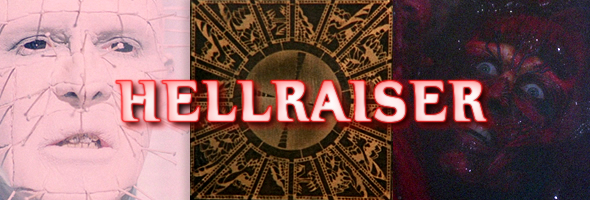
HELLRAISER
Color, 1987, 94m.
Directed by Clive Barker
Starring Andrew Robinson, Clare Higgins, Ashley Laurence, Sean Chapman, Oliver Smith, Robert Hines, Doug Bradley
Arrow Films (Blu-ray & DVD) (UK RB HD), Image/Anchor Bay (Blu-ray & DVD) (US RA/R1 HD/NTSC), Kinowelt (Blu-ray & DVD) (Germany/Italy RB/R2 HD/PAL), Boulevard (DVD) (UK R2 PAL) / WS (1.85:1) (16:9)
HELLBOUND: HELLRAISER II
Color, 1988, 99m.
Directed by Tony Randel
Starring Ashley Laurence, Clare Higgins, Kenneth Cranham, Imogen Boorman, William Hope, Doug Bradley
Arrow Films (Blu-ray & DVD) (UK RB HD), Image/Anchor Bay (Blu-ray & DVD) (US RA/R1 HD/NTSC), Koch (Blu-ray & DVD) (Germany/Italy RB/R2 HD/PAL), Boulevard (DVD) (UK R2 PAL) / WS (1.85:1) (16:9)
HELLRAISER III: HELL ON EARTH
Color, 1992, 93m.
Directed by Anthony Hickox
Starring
Terry Farrell, Doug Bradley, Kevin Bernhardt, Ken Carpenter, Paula Marshall
Arrow Films (Blu-ray & DVD) (UK RB HD), Studio Canal (Blu-ray & DVD) (Germany RB/R2 HD/PAL), Echo Bridge (DVD) (US R1 NTSC) / WS (1.85:1) (16:9)
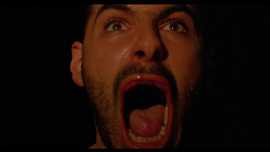
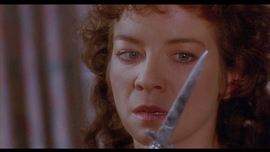 Audiences had no idea what hit them in 1987 when Hellraiser hit local movie theater screens. With slasher films fading out apart from the increasingly wisecracking antics of Freddy Krueger, the latest regime at New World Pictures was looking something new with cheap but successful films like Children of the Corn and House. They definitely spotted something new with this British production, the directorial debut of horror author wunderkind Clive Barker whose Books of Blood had confronted readers with graphic but poetic tales of grotesqueries and extreme sexual experimentation.
Audiences had no idea what hit them in 1987 when Hellraiser hit local movie theater screens. With slasher films fading out apart from the increasingly wisecracking antics of Freddy Krueger, the latest regime at New World Pictures was looking something new with cheap but successful films like Children of the Corn and House. They definitely spotted something new with this British production, the directorial debut of horror author wunderkind Clive Barker whose Books of Blood had confronted readers with graphic but poetic tales of grotesqueries and extreme sexual experimentation.
That sensibility carried over here undiluted as he unleashed a torrent of skin flying, chains, body piercings, and splashing blood aplenty for this adaptation of his novella, The Hellbound Heart. What we have here is a sort of perverse love triangle as recently married Julia (Higgins) and Larry (Dirty Harry's Robinson) move into the house formerly occupied by Larry's brother, Frank (Chapman), who has dropped out of sight after tinkering with an elaborate golden trick box called the Lament Configuration and plunging into a hellish netherworld. While moving in some furniture, Larry drags his hand across a nail and unleashes a fresh supply of blood that turns out to be the key to bringing Frank back from the dead, albeit very slowly and not in complete form. As it turns out, Julia was also Frank's lover, and she's darkly aroused by his return... albeit without any skin. To continue his regeneration, she seeks out horny local men to bring back to the house and bash over the head, providing the fleshy sustenance Frank craves to be whole again. Complicating things is the arrival of Larry's daughter, Kirsty (Laurence), who sparks a mild romance with local dullard Steve (Hines) and starts to suspect that something strange is up with the murderous pair. Then there's the fact that, in his absence, 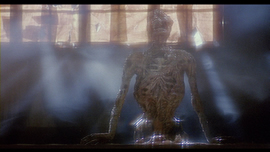 Frank was tangling with the Cenobites, a group of dark beings with a knack for finding out their targets' darkest desires and unleashing their id on a truly twisted, punishing scale.
Frank was tangling with the Cenobites, a group of dark beings with a knack for finding out their targets' darkest desires and unleashing their id on a truly twisted, punishing scale.
As everyone knows now, this film turned out to be a launching pad for the one element that has remained constant in all of its sequels: Pinhead, essentially the leader of the Cenobites, played with theatrical relish by Doug Bradley. Though he and his cadre have only a few minutes of screen time here, his pincushion face and dark eyes were enough to make him the literal poster 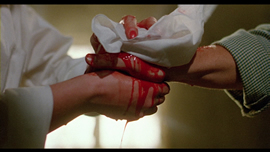 boy for this film and its mascot in all future installments. With that in mind, newcomers may be surprised at the darkly romantic tone of this first film, which plays with tropes like the evil stepmother and doomed lovers to churn out a string of set pieces so extreme you have to wonder whether the MPAA was napping out back when they awarded this an R rating, demanding only a handful of slight cuts to reduce its "tone." Apart from Bradley, the most valuable players here are definitely Laurence, a very likable heroine at a time when good final girls were in short supply, and Higgins and Robinson, who have fun with their roles for reasons that can't be expounded upon here without spoiling the finale. (Robinson's final line was improvised on the spot and remains one of the greatest moments in late '80s horror.) It's also a visually striking film with lots of bold lighting, inventive makeup designs, and nifty production design, all supported by a memorably barnstorming music score by the great Christopher Young (a New World favorite stepping in when the studio rejected an early submission by British group Coil). Unfortunately New World's involvement led to a few unfortunate issues, namely the imposition of atrocious, disturbingly flat American dubbed voices on Chapman (and his skinless incarnation played by Oliver Smith) and Hines, which sound absolutely awful and flat. Few viewers noticed the tinkering, however, and the film became a big hit despite a lot of critical grousing at the time like Roger Ebert's half-star review that posed the question, "Who goes to see movies like this? What do they get out of them?"
boy for this film and its mascot in all future installments. With that in mind, newcomers may be surprised at the darkly romantic tone of this first film, which plays with tropes like the evil stepmother and doomed lovers to churn out a string of set pieces so extreme you have to wonder whether the MPAA was napping out back when they awarded this an R rating, demanding only a handful of slight cuts to reduce its "tone." Apart from Bradley, the most valuable players here are definitely Laurence, a very likable heroine at a time when good final girls were in short supply, and Higgins and Robinson, who have fun with their roles for reasons that can't be expounded upon here without spoiling the finale. (Robinson's final line was improvised on the spot and remains one of the greatest moments in late '80s horror.) It's also a visually striking film with lots of bold lighting, inventive makeup designs, and nifty production design, all supported by a memorably barnstorming music score by the great Christopher Young (a New World favorite stepping in when the studio rejected an early submission by British group Coil). Unfortunately New World's involvement led to a few unfortunate issues, namely the imposition of atrocious, disturbingly flat American dubbed voices on Chapman (and his skinless incarnation played by Oliver Smith) and Hines, which sound absolutely awful and flat. Few viewers noticed the tinkering, however, and the film became a big hit despite a lot of critical grousing at the time like Roger Ebert's half-star review that posed the question, "Who goes to see movies like this? What do they get out of them?"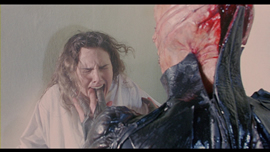
Not surprisingly, Hellraiser has remained a popular title on home video and stayed in circulation readily since its original VHS release from New World, the first edition of which was completely sabotaged by a ridiculous product promotion at the beginning and during the end credits. The laserdisc release at the same time from Image treated the film a little more respectably, but the first really worthwhile edition was a 1996 Barker-autographed laserdisc edition in a striking embossed black box released by Lumivision, containing a widescreen version of the film, a pretty dry solo commentary with Baker, the U.S. trailer, Cenobite drawings, the original screenplay as a gallery, and most fascinating of all, a rough cut of an international trailer featuring Smith's original voice as Frank (which sounds a thousand times better) and gory deleted shot of a cranium getting split with a hammer. Two years later, Anchor Bay released the first DVD of the film (as a standalone disc or in a tin with the second film), featuring a pretty good remastered 16x9 transfer, a much better new commentary with Barker and Laurence (which he promoted as being his last word on the subject), the U.S. trailer, an image gallery, and a new 24-minute featurette, "Hellraiser: Resurrection," produced by Barker and featuring Young, Laurence, Bradley, makeup artist Bob Keen, and Young, among others, with Barker himself getting the spotlight surrounded by flickering candles and moody blue lighting. Anchor Bay later produced a slightly expanded 20th anniversary disc release in 2007, adding on a DVD-Rom screenplay and bonus trailers and TV spots plus new interviews with Robinson (16 mins.),Laurence (11 mins.), Young (18 mins.), and a British-produced piece with Bradley (12 mins.) crafted for the 2004 UK DVD. The same a package was carried over with an HD upgrade for the Blu-ray release two years later, featuring a moderately impressive HD transfer and an added pop-up trivia track. Unfortunately that release went out of circulation after a couple of years, and even more unfortunately, the film wound up as part of a New World package with Image Entertainment, whose indifferent handling of that catalog quickly became notorious. Their Blu-ray and DVD reissues as part of their "Midnight Madness Series" only featured the U.S. trailer, making one wonder why they even bothered with it at all.
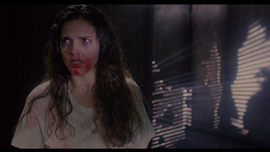
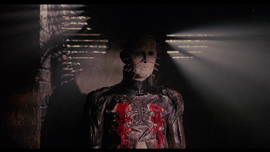 However, anyone with Region B Blu-ray capability will be much better served by the 2015 Arrow Films release, a limited edition called The Scarlet Box containing the first three films in the series. (More on the other two titles in a moment.) The new 2K restoration of the film is easily the best it's looked on home video, pulling out as much detail as possible from the often dark, shadowy interiors while retaining that distinctive late '80s grain. Colors look fantastic, with those all-important reds looking as vibrant as ever, and the DTS-HD MA 5.1 mix and PCM 2.0 stereo tracks sound great with plenty of presence for Young's score. Optional English subtitles are also included for this and the other two films, and it comes packaged with a 200-page hardback book featuring new essay by Phil and Sarah Stokes, plus exclusive art cards, a fold-out poster, and a 20-page bonus booklet with original concept art. As for the extras, you get both of Barker's previous commentaries (including what appears to be the first time his solo track has been out since the Lumivision release), the original EPK, the "Hellraiser: Resurrection" featurette, a gallery of stills and poster art, TV spots, the standard and red band U.S. trailer, that aforementioned international trailer, and the "Under the Skin" Bradley featurette with Bradley talking about his school days with Barker and getting the gig on this film, unaware of the icon he would become. The biggest new extra here is the feature-length "Leviathan: The Story of Hellraiser," an 89-minute look at the film narrated by Smith and featuring many participants from the film including several actors (Bradley, Robinson, and Higgins, most prominently) plus Image Animation's Bob Keen, John Cormican, Roy Puddefoot, Simon Sayce, and Geoff Portass, Oliver Parker, writer Peter Atkins, producer Christopher Figg, composer Young (who talks more here than usual about the Coil score), Tony Randel, camera operator David Worley, and assistant director Selwyn Roberts. (Barker and Laurence are only present in a few archival interview clips.) It's a really thorough and dense piece of work that goes through the entire process from inception through release, and apart from some pretty iffy sound recording and editing in spots (the stereo camera mic on Bradley being a particular problem), it's likely to become the final word on the subject and comes highly recommended. Next up are some a pair of new featurettes produced by Nucleus Films, starting with the 26-minute "Being Frank" is an excellent chat with Chapman, offering what amounts to a career retrospective touching on other projects like Scum and the Barker-penned Transmutations. His stories about the production are a lot of fun including the perils of being spun upside down with fake blood going up your nose, though he refutes the urban legend that he threw up after shooting it. (He's also not much of a fun of the dub job on his character either.) "Soundtrack Hell" is a fascinating, much-needed 18-minute look at the unused Coil score featuring member Stephen Thrower (who also appears briefly in "Leviathan") giving a very in-depth of the account of the state of their musical experiments at the time and how Barker intended it to fit into the film, with a few samples demonstrating how it would have sounded in the film. Also included if you're using a computer are two drafts of the screenplay, which contain a few interesting deviations from the final product.
However, anyone with Region B Blu-ray capability will be much better served by the 2015 Arrow Films release, a limited edition called The Scarlet Box containing the first three films in the series. (More on the other two titles in a moment.) The new 2K restoration of the film is easily the best it's looked on home video, pulling out as much detail as possible from the often dark, shadowy interiors while retaining that distinctive late '80s grain. Colors look fantastic, with those all-important reds looking as vibrant as ever, and the DTS-HD MA 5.1 mix and PCM 2.0 stereo tracks sound great with plenty of presence for Young's score. Optional English subtitles are also included for this and the other two films, and it comes packaged with a 200-page hardback book featuring new essay by Phil and Sarah Stokes, plus exclusive art cards, a fold-out poster, and a 20-page bonus booklet with original concept art. As for the extras, you get both of Barker's previous commentaries (including what appears to be the first time his solo track has been out since the Lumivision release), the original EPK, the "Hellraiser: Resurrection" featurette, a gallery of stills and poster art, TV spots, the standard and red band U.S. trailer, that aforementioned international trailer, and the "Under the Skin" Bradley featurette with Bradley talking about his school days with Barker and getting the gig on this film, unaware of the icon he would become. The biggest new extra here is the feature-length "Leviathan: The Story of Hellraiser," an 89-minute look at the film narrated by Smith and featuring many participants from the film including several actors (Bradley, Robinson, and Higgins, most prominently) plus Image Animation's Bob Keen, John Cormican, Roy Puddefoot, Simon Sayce, and Geoff Portass, Oliver Parker, writer Peter Atkins, producer Christopher Figg, composer Young (who talks more here than usual about the Coil score), Tony Randel, camera operator David Worley, and assistant director Selwyn Roberts. (Barker and Laurence are only present in a few archival interview clips.) It's a really thorough and dense piece of work that goes through the entire process from inception through release, and apart from some pretty iffy sound recording and editing in spots (the stereo camera mic on Bradley being a particular problem), it's likely to become the final word on the subject and comes highly recommended. Next up are some a pair of new featurettes produced by Nucleus Films, starting with the 26-minute "Being Frank" is an excellent chat with Chapman, offering what amounts to a career retrospective touching on other projects like Scum and the Barker-penned Transmutations. His stories about the production are a lot of fun including the perils of being spun upside down with fake blood going up your nose, though he refutes the urban legend that he threw up after shooting it. (He's also not much of a fun of the dub job on his character either.) "Soundtrack Hell" is a fascinating, much-needed 18-minute look at the unused Coil score featuring member Stephen Thrower (who also appears briefly in "Leviathan") giving a very in-depth of the account of the state of their musical experiments at the time and how Barker intended it to fit into the film, with a few samples demonstrating how it would have sounded in the film. Also included if you're using a computer are two drafts of the screenplay, which contain a few interesting deviations from the final product.
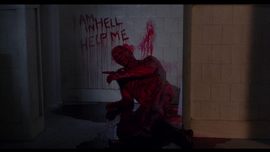
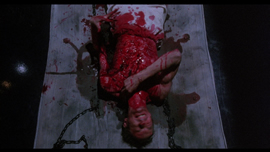 Naturally New World was keen to release a sequel, so the following year saw the release of Hellbound: Hellraiser II, which pushed the gore levels much higher and suffered far more at the hands of the MPAA. Fortunately the unrated version eventually debuted on VHS and has remained the standard ever since in most countries, with an additional sequence reinstated showing Kirsty in a bedroom with photographs turning into a bloody, cockroach-laden nightmare. Barker prepped the story for the film but was in the process of writing novels and getting ready to do Nightbreed, so directing duties were handed over to Tony Randel, a New World executive and editor who stepped in when planned writer-director Michael McDowell suffered medical setbacks. Peter Atkins returned to write the screenplay, and the returning cast included Higgins, Laurence, Chapman (finally using his real voice), and Bradley, with Robinson's absence causing a few story issues that were never quite resolved. This one actually turned out quite well as far as horror sequels go, with Young offering another great blood and thunder score and the effects crew conjuring up some truly surreal, nightmarish images culminating in a trip to the underworld itself.
Naturally New World was keen to release a sequel, so the following year saw the release of Hellbound: Hellraiser II, which pushed the gore levels much higher and suffered far more at the hands of the MPAA. Fortunately the unrated version eventually debuted on VHS and has remained the standard ever since in most countries, with an additional sequence reinstated showing Kirsty in a bedroom with photographs turning into a bloody, cockroach-laden nightmare. Barker prepped the story for the film but was in the process of writing novels and getting ready to do Nightbreed, so directing duties were handed over to Tony Randel, a New World executive and editor who stepped in when planned writer-director Michael McDowell suffered medical setbacks. Peter Atkins returned to write the screenplay, and the returning cast included Higgins, Laurence, Chapman (finally using his real voice), and Bradley, with Robinson's absence causing a few story issues that were never quite resolved. This one actually turned out quite well as far as horror sequels go, with Young offering another great blood and thunder score and the effects crew conjuring up some truly surreal, nightmarish images culminating in a trip to the underworld itself.
Following the events of the first film, Dr. Philip Channard (Cranham) has become obsessed with the bloody aftermath of Julia and Frank's killing spree and is determined to find out what forces were behind it all. At his private medical institution, he brings in Kirsty just after her narrow escape from hell and becomes determined to bring back Julia thanks to the aid of a blood-soaked mattress, an insane inmate, and a handy razor blade. That sequence (one of the most extreme in '90s horror) succeeds in bringing a skinless Julia back to the land of the living, and the image of her wrapped in bandages is enough to justify the entire existence of the film. The weirdly aroused Channard also has plans to unlock the secrets of the Lament Configuration with the aid of another inmate, the withdrawn Tiffany (Boorman), who has an uncanny ability for puzzle solving, which sets off a horrific chain of events that plunges all of the major characters into a maze-like realm of monsters where irrationality and the Cenobites reign supreme. 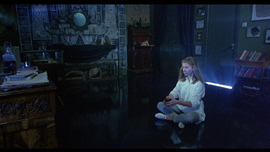
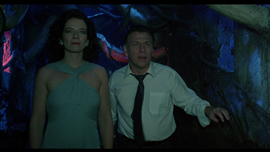 The first third or so of this film is still powerhouse stuff and the equal of the previous film, though the script eventually starts to stumble enough to take it down a
few notches; in particular, the
final half hour features a lot of sweeping camera movements through corridors and characters running around without much narrative urgency. That issue aside, it's still a very worthwhile installment with Laurence against making for a committed heroine (and Boorman less so in what amounts to a pale copy of Kristen from A Nightmare on Elm Street 3: Dream Warriors), while Bradley and company again make the most of their limited screen time. The plan was still to make Julia the evil center of the ongoing saga, but the public had other opinions and her character would be discarded after this entry in favor of much more screen time for Pinhead in the future.
The first third or so of this film is still powerhouse stuff and the equal of the previous film, though the script eventually starts to stumble enough to take it down a
few notches; in particular, the
final half hour features a lot of sweeping camera movements through corridors and characters running around without much narrative urgency. That issue aside, it's still a very worthwhile installment with Laurence against making for a committed heroine (and Boorman less so in what amounts to a pale copy of Kristen from A Nightmare on Elm Street 3: Dream Warriors), while Bradley and company again make the most of their limited screen time. The plan was still to make Julia the evil center of the ongoing saga, but the public had other opinions and her character would be discarded after this entry in favor of much more screen time for Pinhead in the future.
The home video trajectory of this film was essentially the same as the first one except for the deluxe laserdisc bit, so once again the Arrow box does it proud with a stacked edition featuring the unrated cut in a new 2K restoration that looks just as solid. This is also a very dark, stylized film, and the black levels are now as deep and dense as they should be without any compression issues clogging 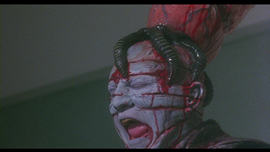 things up. (Most past transfers were way too bright, turning the labyrinth scenes in particular into a grayish sludge.)
things up. (Most past transfers were way too bright, turning the labyrinth scenes in particular into a grayish sludge.) 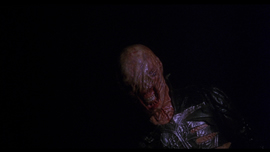 A solid audio commentary with Randel and Atkins is carried over here along with the vintage 17-minute "Lost in the Labyrinth" featurette (with essentially the same participants as the one for the first film) from Anchor Bay's DVD, plus the usual standard and red band trailers and a pair of TV spots. You also get an alternate audio commentary with Randel, Laurence and Atkins, a 3-minute interview with Barker on the set (basically PR fluff), another round of EPK-style interviews from the set (5 mins.) with Randel, Higgins, Laurence, Boorman, et al chatting during the shoot, and two minutes of raw behind-the-scenes footage with a cool look at Bradley and the other Cenobites getting into makeup. The more substantial extras here are continuations of the prior disc with both Chapman and Bradley getting sequel featurettes (11 mins. each), both mainly talking about the logistics of doing effects-laden scenes including Bradley's discussion of a notorious scene involving Pinhead and the Cenobites in surgical garb, a shot from which wound up on one of the video boxes. Bradley claims the scene was never filmed due to the difficulty of disguising his identity behind a mask, but in fact that scene was recovered from this release in workprint form and is presented full frame with a raw audio mix and a couple of video slugs for missing effects shots. Much of the formerly lost sequence is pretty clunky, but the punchline at the end involving an elevator offers a great little jolt that wound up popping up fleetingly in the trailer. However, the biggest bonus feature here is a sequel "Leviathan" doc about the making of this film, running an astonishing two hours on the dot and featuring the same participants talking about its creation (with more time given to the lovely Barbie Wilde, who played the female Cenobite in this one). It's a little overlong, but there's a lot of ground to cover here with Randel in particular
A solid audio commentary with Randel and Atkins is carried over here along with the vintage 17-minute "Lost in the Labyrinth" featurette (with essentially the same participants as the one for the first film) from Anchor Bay's DVD, plus the usual standard and red band trailers and a pair of TV spots. You also get an alternate audio commentary with Randel, Laurence and Atkins, a 3-minute interview with Barker on the set (basically PR fluff), another round of EPK-style interviews from the set (5 mins.) with Randel, Higgins, Laurence, Boorman, et al chatting during the shoot, and two minutes of raw behind-the-scenes footage with a cool look at Bradley and the other Cenobites getting into makeup. The more substantial extras here are continuations of the prior disc with both Chapman and Bradley getting sequel featurettes (11 mins. each), both mainly talking about the logistics of doing effects-laden scenes including Bradley's discussion of a notorious scene involving Pinhead and the Cenobites in surgical garb, a shot from which wound up on one of the video boxes. Bradley claims the scene was never filmed due to the difficulty of disguising his identity behind a mask, but in fact that scene was recovered from this release in workprint form and is presented full frame with a raw audio mix and a couple of video slugs for missing effects shots. Much of the formerly lost sequence is pretty clunky, but the punchline at the end involving an elevator offers a great little jolt that wound up popping up fleetingly in the trailer. However, the biggest bonus feature here is a sequel "Leviathan" doc about the making of this film, running an astonishing two hours on the dot and featuring the same participants talking about its creation (with more time given to the lovely Barbie Wilde, who played the female Cenobite in this one). It's a little overlong, but there's a lot of ground to cover here with Randel in particular 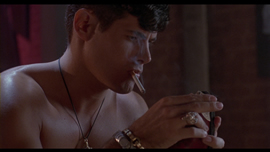 getting in some great stories about the tonal and story shifts executed for this more operatic installment.
getting in some great stories about the tonal and story shifts executed for this more operatic installment.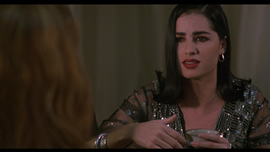
That brings us to the film that really started to divide the horror crowd and a sign of the more splintered, erratic directions the series would take in future sequels. Dropping any hints of the British origins of the prior two films, Hellraiser III: Hell on Earth was shot in North Carolina and released by Miramax's Dimension Films arm with an eye squarely on the youth market. Atkins wrote the screenplay after developing story ideas with Randel and Barker (who kept a "presents" and executive producer nod for this one, his last direct participation in the series), with a drastically increased role for Pinhead and his former human incarnation, a World War I soldier named Elliott Spencer (briefly touched on in Hellbound). Randel was unimpressed with the script and opened the door for a third director in the series, Anthony Hickox, who had directed the fan favorite Waxwork and would soon go on to helm the truly nutty Warlock: The Armageddon. The end result here is a horror film that screams "1992" from every single frame, which is either a major asset or a complete embarrassment depending on your perspective. There's a reason this isn't remotely as well regarded as its predecessors, but for pulpy Clinton-era gory chills, it certainly has its moments and offers some truly daffy concepts like new Cenobites complete with body modifications involving a camera and multiple compact discs. 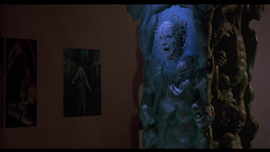
With no Kirsty in sight, heroine duties are handed off this time to an up and coming reporter named Joey Summerskill (Farrell), who senses a big story when a nightclub patron ends up in the emergency room torn up by hooked chains. 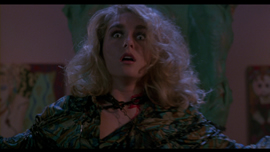 Naturally that means another debauched hedonist is trying to get in touch with his inner Cenobite, and in this case it's beefcake-y nightclub owner J.P. Monroe (Bernhardt), who has a habit of mistreating his one-night stands. However, that hits an all-new level when one unlucky lady gets bloodily sucked into a statue containing the imprisoned forms of Pinhead and pals, which in turn sets them loose to wreak sadistic havoc on everyone downstairs in J.P.'s club. Meanwhile Joey teams up with eyewitness Terri (Marshall), who has a particularly twisted future in store, and discovers that she may have a secret tie to the marauding Cenobite's human alter ego.
Naturally that means another debauched hedonist is trying to get in touch with his inner Cenobite, and in this case it's beefcake-y nightclub owner J.P. Monroe (Bernhardt), who has a habit of mistreating his one-night stands. However, that hits an all-new level when one unlucky lady gets bloodily sucked into a statue containing the imprisoned forms of Pinhead and pals, which in turn sets them loose to wreak sadistic havoc on everyone downstairs in J.P.'s club. Meanwhile Joey teams up with eyewitness Terri (Marshall), who has a particularly twisted future in store, and discovers that she may have a secret tie to the marauding Cenobite's human alter ego.
Once again the MPAA cracked down on this film, though for some reason a number of perfectly harmless expository scenes bit the dust as well and only turned up later on VHS and laserdisc from Paramount, the last time film elements for the extra footage were ever transferred. (The current whereabouts of those celluloid bits appears to be unknown.) There's some extra gore there (the club massacre, the war trenches, etc.) and a little extra sex, with the background of the Spencer character being the biggest casualty. Overall the film doesn't play all that differently either way, but attempts have been made to present both versions in the best condition possible in a pair of separate releases. First up was the Koch release in Germany, a Blu-ray and DVD set that contained an okay HD presentation of the theatrical cut and an alternate option to play the unrated version with the extra footage spliced in from the laserdisc, zoomed in and matted to 1.78:1. The Arrow Films release takes a similar tactic but features a superior 2K representation of the theatrical cut; the film was never particularly pretty (it looked very, very drab in theaters), but this is probably about as 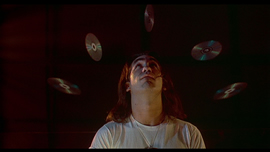 vibrant as it's going to get. A handful of effects shots (especially the creation of the CD Cenobite - see image on the left) appear to have been generated on video with some telltale aliasing and a reduction in resolution, so that ugliness was always inherent in the
vibrant as it's going to get. A handful of effects shots (especially the creation of the CD Cenobite - see image on the left) appear to have been generated on video with some telltale aliasing and a reduction in resolution, so that ugliness was always inherent in the 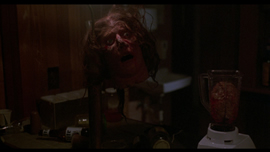 original film. The unrated cut is tucked away in the special features and features the same 2K transfer for the bulk of the film with the extra bits pulled from the laserdisc, but this time presented open matte at 1.33:1. The shift in aspect ratios is pretty jarring, but the effort is laudable since this is about as good as it's going to get barring a miracle in the vaults someday. Interestingly, the theatrical cut on both the U.K. and German Blu-rays actually features the extra carnage in the club scene transferred in HD, so how that happened is a mystery.
original film. The unrated cut is tucked away in the special features and features the same 2K transfer for the bulk of the film with the extra bits pulled from the laserdisc, but this time presented open matte at 1.33:1. The shift in aspect ratios is pretty jarring, but the effort is laudable since this is about as good as it's going to get barring a miracle in the vaults someday. Interestingly, the theatrical cut on both the U.K. and German Blu-rays actually features the extra carnage in the club scene transferred in HD, so how that happened is a mystery.
Not surprisingly, the extras are a little more sparse this time with the biggest being "Hell on Earth," a new 32-minute piece that basically continues with the style and some of the participants from the previous two "Leviathan" docs. Everyone's pretty candid about the issues with this film and the compromises involved, with Bradley, camerahead Ken Carpenter, Cranham, Figg, Atkins, and Randel covering the production mainly in the development stages with Pinhead's popularity really beginning to soar. A separate 15-minute interview by Red Shirt Pictures with Marshall is a really fun piece with the energetic actress, who went on to a very productive TV career and chats a lot about the very challenging makeup involved in her big transformation. Hickox gets a rare moment in front of the camera for an older 14-minute piece by Nucleus Films with a focus on the Southern locations of the shoot, his lack of deep familiarity with the subject matter when he came aboard, and some of the production speed bumps along the way. A third Bradley interview runs 13 minutes (another of the Nucleus featurettes for the UK disc) with a pretty positive spin on the whole experience and a focus on the increasingly laconic one liners he was given. Also included are the original 5-minute EPK, 23 minutes of silent special effects dailies (including some great, lingering shots at gore effects barely glimpsed in the final film), the theatrical trailer, a comic adaptation (in gallery form), and a gallery of stills and promotional artwork. The feature itself also features a pair of commentaries with Atkins for the theatrical cut (moderated by Red 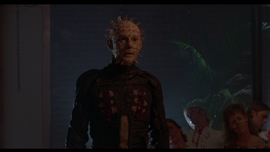 Shirt's Michael Felsher) and an archival one with Hickox and Bradley from the British DVD on the unrated one; both tracks are entertaining with the participants in good spirits, including some fascinating discussions of the challenges of integrating story elements and characters from past entries into this film on more limited means.
Shirt's Michael Felsher) and an archival one with Hickox and Bradley from the British DVD on the unrated one; both tracks are entertaining with the participants in good spirits, including some fascinating discussions of the challenges of integrating story elements and characters from past entries into this film on more limited means.
If that's not enough Barker for you, the Arrow box also contains an exclusive fourth disc called "The Clive Barker Legacy." As you'd probably guess, it kicks off with the two short films he made before 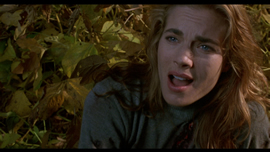 Hellraiser, "Salomé" and "The Forbidden," which are black and white with several visual motifs that would turn up later in his feature films. In particular, the latter Faustian film features an ecstatic flaying sequence that feels like a dry run for the Cenobites in action, plus the fact that Bradley appears in it along with Barker himself, wearing face makeup and dancing around naked with an erection for about five minutes. Top that one, Stephen King. As with the early 2000 DVD release from Redemption Films, both shorts are presented in SD complete with intros featuring Barker, Atkins, and Bradley recalling their creation. The 48-minute "Hellraiser: Evolutions" takes a broader overview of the entire series, with a returning Randel, Young, Atkins, and Bradley joined by executive producer David Saunders, Hellraiser: Inferno director Scott Derrickson, Hellrasier: Hellseeker director Rick Bota, series makeup artist Gary J. Tunnicliffe, writer Neal Marshall Stevens, author Del Howison, screenwriter Tim Day, actors Khary Payton and Kari Wuhrer, and (briefly) filmmaker Stuart Gordon sharing some additional stories about making the first film (such as temp tracking John Williams' The Fury into Frank's resurrection) and pulling apart some of the themes and the enduring appeal of the imagery and aesthetic pleasures of the original films and its successors. And yes, there is a funny bit with Bradley talking about the disastrous Hellraiser: Revelations, which cast a different actor as Pinhead. The interesting 31-minute short film "The Hellraiser Chronicles: A Question of Faith" is basically a shot on video project from 2004 designed to help pitch a TV series built around the franchise, but it features some pretty nifty stop motion animation at the beginning and actually functions as a tantalizing glimpse of what an anthology show in that universe might have looked like, albeit with a more overt religious bent here than the big screen series. In the 19-minute "Books of Blood & Beyond: The Literary Works of Clive Barker," teen horror author David Gatward covers the Barker literary phenomenon from his groundbreaking short story collection through his novels from The Damnation Game through The Scarlet Gospels, with a few film adaptations covered along the way including Rawhead Rex, Nightbreed, Candyman, Lord of Illusions, Book of Blood, Dread, Quicksilver Highway, and The Midnight Meat Train. It's a fun primer for newcomers and a good refresher course for more seasoned fans, which should send more than a few people to their nearest bookshelf or bookstore (physical or online) as soon as it's over. Needless to say, this is not only one of the year's standout releases but one of the best Arrow deluxe sets released to date.
Hellraiser, "Salomé" and "The Forbidden," which are black and white with several visual motifs that would turn up later in his feature films. In particular, the latter Faustian film features an ecstatic flaying sequence that feels like a dry run for the Cenobites in action, plus the fact that Bradley appears in it along with Barker himself, wearing face makeup and dancing around naked with an erection for about five minutes. Top that one, Stephen King. As with the early 2000 DVD release from Redemption Films, both shorts are presented in SD complete with intros featuring Barker, Atkins, and Bradley recalling their creation. The 48-minute "Hellraiser: Evolutions" takes a broader overview of the entire series, with a returning Randel, Young, Atkins, and Bradley joined by executive producer David Saunders, Hellraiser: Inferno director Scott Derrickson, Hellrasier: Hellseeker director Rick Bota, series makeup artist Gary J. Tunnicliffe, writer Neal Marshall Stevens, author Del Howison, screenwriter Tim Day, actors Khary Payton and Kari Wuhrer, and (briefly) filmmaker Stuart Gordon sharing some additional stories about making the first film (such as temp tracking John Williams' The Fury into Frank's resurrection) and pulling apart some of the themes and the enduring appeal of the imagery and aesthetic pleasures of the original films and its successors. And yes, there is a funny bit with Bradley talking about the disastrous Hellraiser: Revelations, which cast a different actor as Pinhead. The interesting 31-minute short film "The Hellraiser Chronicles: A Question of Faith" is basically a shot on video project from 2004 designed to help pitch a TV series built around the franchise, but it features some pretty nifty stop motion animation at the beginning and actually functions as a tantalizing glimpse of what an anthology show in that universe might have looked like, albeit with a more overt religious bent here than the big screen series. In the 19-minute "Books of Blood & Beyond: The Literary Works of Clive Barker," teen horror author David Gatward covers the Barker literary phenomenon from his groundbreaking short story collection through his novels from The Damnation Game through The Scarlet Gospels, with a few film adaptations covered along the way including Rawhead Rex, Nightbreed, Candyman, Lord of Illusions, Book of Blood, Dread, Quicksilver Highway, and The Midnight Meat Train. It's a fun primer for newcomers and a good refresher course for more seasoned fans, which should send more than a few people to their nearest bookshelf or bookstore (physical or online) as soon as it's over. Needless to say, this is not only one of the year's standout releases but one of the best Arrow deluxe sets released to date.
Note: preorders for this set are currently sold out, but keep an eye out for copies after street date. Judging from the wording used for the set, the first three discs will most likely be issued as separate releases at a later date as well.
Reviewed on October 22, 2015.






















